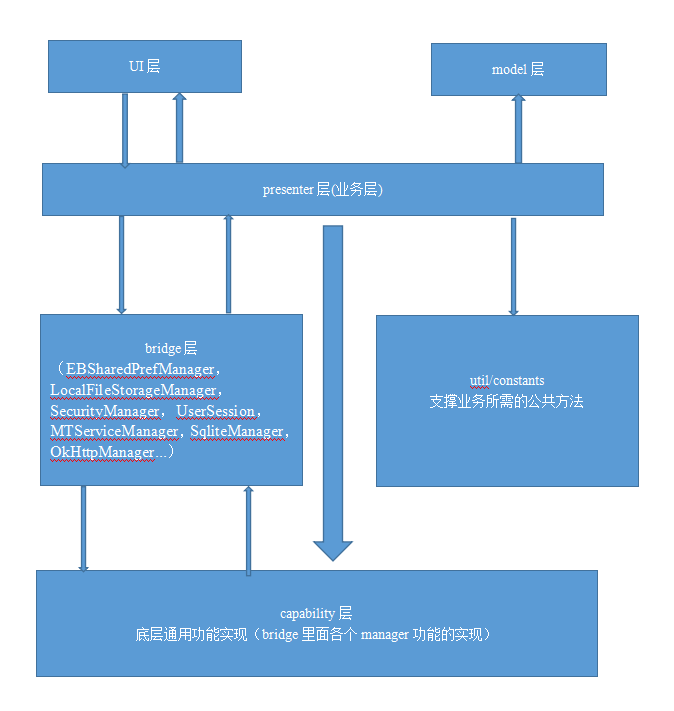編輯:關於Android編程
1、定義:
Define an interface for creating an object, but let subclasses decide which class to instantiate.
Factory Method lets a class defer instantiation to subclasses.
定義一個用於創建對象的接口,讓子類決定實例化哪個類。
2、意義:
工廠方法使得類的實例化延伸到子類。
3、四大角色:
3.1、抽象工廠:工廠方法模式的核心,任何在模式中創建對象的工廠類必須實現這個接口。
3.2、具體工廠:實現了抽象工廠接口的具體JAVA類。具體工廠角色含有與業務密切相關的邏輯,並且受到使用者的調用以創建導出類。
3.3、抽象角色:工廠方法模式所創建的對象的超類。
3.4、具體角色:實現抽象角色的某個具體角色的實例。
4、優點:
4.1、工廠方法模式是完全符合開閉原則的;
4.2、擯棄了簡單工廠模式的缺點;
4.3、工廠模式是一種典型的解耦模式,可以降低對象之間的耦合度;
4.4、工廠模式是依靠抽象架構的,它把實例化產品的任務交由實現類完成,擴展性比較好。
4.5、可以使代碼結構清晰,有效地封裝變化。
4.6、對調用者屏蔽具體的產品類。如果使用工廠模式,調用者只關心產品的接口就可以了,至於具體的實現,調用者根本無需關心。即使變更了具體的實現,對調用者來說沒有任何影響。
5、缺點:
簡單的對象應用時,不適合工廠方法模式。
6、寫了一個簡單的demo:
首先是普通的 抽象 對象
package com.example.demo.FactoryMethod; /** * 抽象角色 * @author qubian * @data 2015年6月4日 * @email [email protected] * */ public interface Lottery { public String getLotteryName(); }實現:
package com.example.demo.FactoryMethod; /** * 具體角色 * @author qubian * @data 2015年6月4日 * @email [email protected] * */ public class SSQLottery implements Lottery{ @Override public String getLotteryName() { return "雙色球"; } } package com.example.demo.FactoryMethod; /** * 具體角色 * @author qubian * @data 2015年6月4日 * @email [email protected] * */ public class DLTLottery implements Lottery{ @Override public String getLotteryName() { return "大樂透"; } }
package com.example.demo.FactoryMethod; /** * 抽象工廠 * @author qubian * @data 2015年6月4日 * @email [email protected] * */ public interface LotteryFactory { public Lottery getLottery(); }
package com.example.demo.FactoryMethod; /** * 具體工廠 * @author qubian * @data 2015年6月4日 * @email [email protected] * */ public class SSQFactory implements LotteryFactory{ @Override public Lottery getLottery() { return new SSQLottery(); } } package com.example.demo.FactoryMethod; /** * 具體角色 * @author qubian * @data 2015年6月4日 * @email [email protected] * */ public class DLTLottery implements Lottery{ @Override public String getLotteryName() { return "大樂透"; } }
package com.example.demo.FactoryMethod; import android.util.Log; /** * 工廠方法的使用 * * @author qubian * @data 2015年6月4日 * @email [email protected] * */ public class UseFactory { private static final String TAG="UseFactory"; public void use() { //若是需要修改,只需要修改 new SSQFactory(); 即可; // LotteryFactory factory= new SSQFactory(); //此處的操作完成是,接口的操作; // 也就是說:使用工廠模式,調用者只關心產品的接口就可以了, //至於具體的實現,調用者根本無需關心。即使變更了具體的實現,對調用者來說沒有任何影響。 Lottery lottery = factory.getLottery(); Log.i(TAG,lottery.getLotteryName()); } }
1、 關於ArrayList,HashSet,與 Iterator 之間都能算是一種工廠方法;
Setset = new HashSet (); Iterator iterator = set.iterator(); while(iterator.hasNext()) { // 具體操作 } List list =new ArrayList (); Iterator it = list.iterator(); while(it.hasNext()) { // 具體操作 }
/**
* A {@code Set} is a data structure which does not allow duplicate elements.
*
* @since 1.2
*/
public interface Set extends Collection
{
/**
* Returns an iterator on the elements of this {@code List}. The elements are
* iterated in the same order as they occur in the {@code List}.
*
* @return an iterator on the elements of this {@code List}.
* @see Iterator
*/
public Iterator iterator();
}
/**
* A {@code List} is a collection which maintains an ordering for its elements. Every
* element in the {@code List} has an index. Each element can thus be accessed by its
* index, with the first index being zero. Normally, {@code List}s allow duplicate
* elements, as compared to Sets, where elements have to be unique.
*/
public interface List extends Collection
{
/**
* Returns an iterator on the elements of this {@code List}. The elements are
* iterated in the same order as they occur in the {@code List}.
*
* @return an iterator on the elements of this {@code List}.
* @see Iterator
*/
public Iterator iterator();
}
自然,ArrayList與HashMap 都有關於其中的實現了。
public class ArrayListextends AbstractList implements Cloneable, Serializable, RandomAccess { @Override public Iterator iterator() { return new ArrayListIterator(); } private class ArrayListIterator implements Iterator { /** Number of elements remaining in this iteration */ private int remaining = size; /** Index of element that remove() would remove, or -1 if no such elt */ private int removalIndex = -1; /** The expected modCount value */ private int expectedModCount = modCount; public boolean hasNext() { return remaining != 0; } @SuppressWarnings("unchecked") public E next() { ArrayList ourList = ArrayList.this; int rem = remaining; if (ourList.modCount != expectedModCount) { throw new ConcurrentModificationException(); } if (rem == 0) { throw new NoSuchElementException(); } remaining = rem - 1; return (E) ourList.array[removalIndex = ourList.size - rem]; } public void remove() { Object[] a = array; int removalIdx = removalIndex; if (modCount != expectedModCount) { throw new ConcurrentModificationException(); } if (removalIdx < 0) { throw new IllegalStateException(); } System.arraycopy(a, removalIdx + 1, a, removalIdx, remaining); a[--size] = null; // Prevent memory leak removalIndex = -1; expectedModCount = ++modCount; } } }
 Android技能-創建Json文本及Json解析
Android技能-創建Json文本及Json解析
摘要:Json數據在安卓開發過程中是非常常見的,在請求服務器端數據的時候,服務器端返回的無非就是三種類型:HTML,XML,JSON。所以學習JSON對安卓程序員來說是非
 Android Studio常用插件(較常用的在前面)
Android Studio常用插件(較常用的在前面)
JsonOnlineViewer可實現直接在android studio中調試接口數據,可以選擇請求類型,自定義請求頭及請求體,json數據格式化後展示 下載完
 Android應用架構搭建
Android應用架構搭建
1. 前言安卓屬於小團隊開發,架構的重要性在很多公司其實不是那麼的明顯,加上現在的開源框架層出不窮,更好的幫助我們上手android項目的開發。我前兩年也在公司主導過項目
 升級Android ADT 和SDK
升級Android ADT 和SDK
由於目前從事android開發工作,所以升級了下Android SDK和eclipse ADT插件 一、更新ADT Install New Softwar